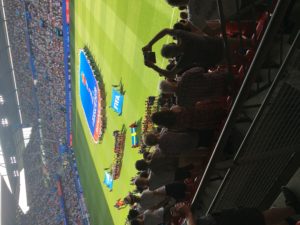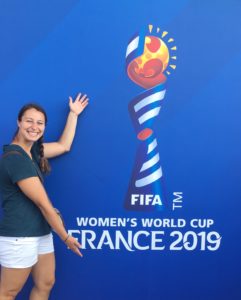It’s hard to believe that I’ve been here in France for four weeks already. The days are long and the weeks short. Time sure has a funny sense of humor.
For instance, it seems like it was just yesterday that I travelled to Rennes to watch the Women’s World Cup Quarter-Final between Sweden and Germany, even though that trip was actually a couple weeks ago. The recent wrap-up of the tournament however has reminded me of my experience in Rennes which was surprising in many ways.
Leading up to the game, there were crowds of people dressed in Sweden’s yellow and Germany’s black jerseys, so I was excited to see what the energy would be like around the stadium itself since I had previously attended a Real Madrid club game five or so years ago in Spain. The passion and overwhelming energy of that elite men’s match was akin to our home football games at Notre Dame, if not even a little more wild, so as I saw more and more fans emerge onto Rennes’ streets as the game time drew nearer, I thought that I would encounter the same emotion as I did in Spain.
I was to be slightly disappointed.
 It’s not that there was no buzz of excitement around Rennes stadium; it’s just that it was significantly less than that of the Real Madrid match I had seen. Perhaps it was because this was a women’s match and female soccer games just traditionally bring in less fans, but I thought that the World Cup component of the game would have reversed that reality. The decreased energy may have also been due to the two teams playing: while both Sweden and Germany have amazing teams with talented players, they do not have the robust fanbase of the American or French national teams. Additionally, based on the people my friend and I encountered at the stadium, most fans were actually American, English, or French, and they were just there because they had wanted to see a game; they didn’t necessarily support either team in particular.
It’s not that there was no buzz of excitement around Rennes stadium; it’s just that it was significantly less than that of the Real Madrid match I had seen. Perhaps it was because this was a women’s match and female soccer games just traditionally bring in less fans, but I thought that the World Cup component of the game would have reversed that reality. The decreased energy may have also been due to the two teams playing: while both Sweden and Germany have amazing teams with talented players, they do not have the robust fanbase of the American or French national teams. Additionally, based on the people my friend and I encountered at the stadium, most fans were actually American, English, or French, and they were just there because they had wanted to see a game; they didn’t necessarily support either team in particular.
 All in all, however, it was a great weekend trip, and I enjoyed watching Sweden advance into the semi-finals. I think my experience of the stadium and initial impressions of the environment, however, just point to how much stronger of a fanbase American women’s soccer has compared to its counterpart in Europe. Our women’s programs in the United States (particularly those at the professional level) are better known and developed than many of Europe’s women’s soccer programs (even if our female athletes still do not get paid as much as the men), but hopefully our most recent World Cup win will serve to improve conditions all around.
All in all, however, it was a great weekend trip, and I enjoyed watching Sweden advance into the semi-finals. I think my experience of the stadium and initial impressions of the environment, however, just point to how much stronger of a fanbase American women’s soccer has compared to its counterpart in Europe. Our women’s programs in the United States (particularly those at the professional level) are better known and developed than many of Europe’s women’s soccer programs (even if our female athletes still do not get paid as much as the men), but hopefully our most recent World Cup win will serve to improve conditions all around.
Aside from the soccer events of the past month, however, this past week at the institute was interesting because it was what they called “oral practice week.” This entailed a slight change in the curriculum of the classes in that all our activities and lessons would be centered around listening comprehension and speaking, rather than also including reading and writing components. I appreciated this change for many reasons, one being that I really wanted to improve my spoken French, and another in that I was able to discuss at length with one of my classmates the different language education systems in our countries. My class partner was from Switzerland, so she explained to me that they begin learning a second language when they are about to start middle school, and then have the option to take on a third during high school. The most common languages they learn are English, German, French, and Italian, although the ones you learn depend on what region of Switzerland you are from because the mother-tongue of each region varies by geography.
I thought this was interesting compared to the education system in the U.S. because at least for my siblings and me, we did not start formally studying a second language until high school. This lack of language introduction within our education system should be remedied because I think there is so much to gain by introducing another language and culture to young students early on. They would be exposed to not only a new system of communication but also the stories and characters behind another country and culture. A new world would be literally at their fingertips through a secondary language, and perhaps this one change in our American education system would help encourage more open-mindedness in the upcoming generations of students. By engaging with a second language earlier, young students could be encouraged to be more curious about other cultures and people unlike themselves, rather than nervous or judgmental about them. At the very least, perhaps this could be a start to building a better world with more fruitful communication.
That’s all for now. À bientôt!